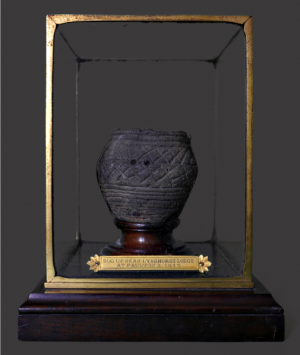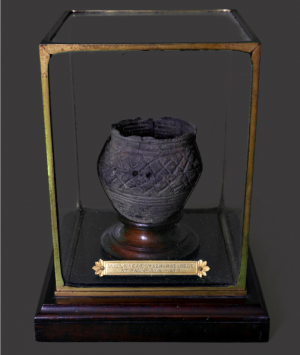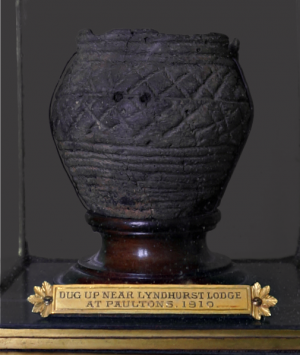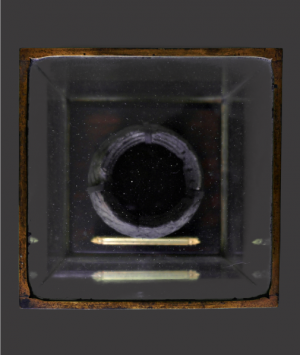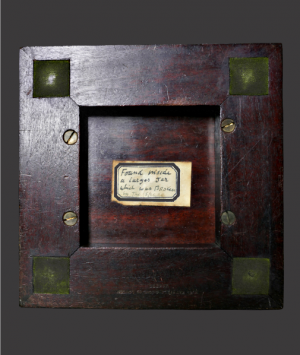Item number: 3381
An Important British Bronze Age Accessory Cup
Discovered at Paultons park, Ower, Hampshire in 1910
Housed in an exceptional Custom Display Case by Royal Cabinetmakers, H. J. Hatfield ltd London
Ex Major R. C. H. Sloane-Stanley Collection
Ex English Private Collection
During the third millennium BC, knowledge of a revolutionary new technology arrived in prehistoric Britain which heralded the dawn of what is commonly referred to today as, ‘The Bronze Age’.
Archaeology suggests that the earliest bronze weapons seen in Britain were never used or sharpened and were actually symbols of power and status. Their introduction coincided with the appearance of a new, highly distinctive style of pottery vessel, characterised as ‘Beakers’, and attributed to a people referred to as, ‘Beaker culture’, arriving from the continent, bringing with them their knowledge of refining metals.
This momentous period in British history is defined by a rich archaeological legacy which provides fascinating, emotive insight in to the lives and beliefs of the populace at this time, with their complex burial practices involving the placement of personal items along with the dead under round earthen mounds, (barrows), the erection and development of elaborate communal ritual sites such as colossal wood and stone circles, and compelling evidence of widespread spiritual belief closely linked to the growing sense of personal ownership, prestige and the value placed on objects.
This is perhaps best seen in the frequently encountered archaeological evidence of ritual sacrifice, the placement of high status objects, particularly tools and weapons, as votive offerings in sacred places, commonly involving a measure of deliberate, deeply symbolic destruction to these valuable, personal items prior to deposition.
Interest in amassing collections of British antiquities of this period really began in earnest during the 19th century having remained relatively overlooked in previous centuries, largely due to the widespread fascination with the ancient classical civilisations of Greece and Rome. Now, wealthy, ‘gentleman antiquarians’, popularised amateur archaeology in to a sport of discovery, becoming known as, ‘Barrow-diggers’, they roamed the countryside, studying strange anomalies in the landscape, drawing and recording ancient monuments. Many important burial mounds and prehistoric sites were excavated and interpreted during this period with varying degrees of sophistication, the finds often incorporated in to growing country house collections of antiquities.
This extremely rare British Bronze Age accessory cup is of particular note aside from its existence, high quality and fine provenance, as there appears to be residual traces of burnt organic material adhering to areas of the interior remaining, likely related to its use prior to ritual deposition during the Bronze Age. There remains some speculation and active debate within the archaeological community and among scholars as to the significance and exact purpose of these small highly emotive vessels, (referred to variously as accessory cups, incense cups, pygmy cups or even narcotic cups!), however the context of their discoveries as a well known component of British Bronze Age grave culture leaves absolutely no doubt that they were obviously considered of great importance.
Believed to be the only example outside a museum collection and remaining in private ownership, this accessory cup was discovered in 1910 in Ower, near Romsey in the New Forest area of Hampshire, ‘ Dug up near Lyndhurst Lodge at Paultons’, as inscribed on its bronze plaque. Further information relating to its discovery is found on an old collection label affixed to the base of the display case stating that it was found inside a lager jar which was broken by the spade! Despite this rather alarming, insensitive approach to the acquisition of this important British Bronze Age antiquity we must assume that the actual discovery and subsequent loss of its companion vessel was most likely the actions of an unskilled labourer employed to dig or perhaps consider the discovery was by chance, as the owner certainly held the piece in very high regard indeed, apparently no expense was spared in the commission of its wonderful display case, manufactured by the eminent cabinetmakers, to Royalty and of the absolute finest quality, H J Hatfield ltd, London, their fine makers mark clearly stamped to the base.
Formerly in the collection of the prominent antiquarian collector and active member of the Hampshire Field Club and Archaeological Society, Major Roger, Cyril, Hans, Sloane-Stanley,(1875-1944), of the Paultons Estate, Ower, Hampshire, great, great grandson of Sir Hans Sloane of Chelsea whose collection formed the foundation of the British Museum, London.
Dimensions (Approximate)
Case: Height: 18.4cm Width: 14.6cm Depth: 14.6cm
Accessory cup: Height: 6cm Width: 6.5cm, (across widest point)

